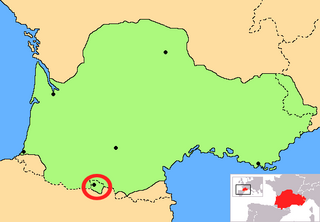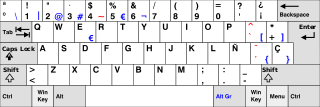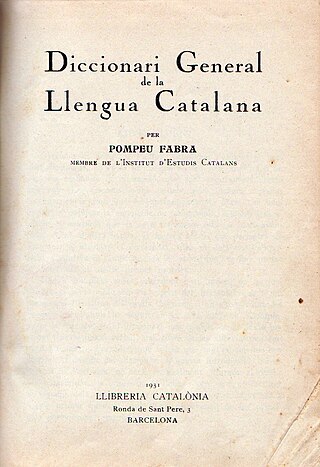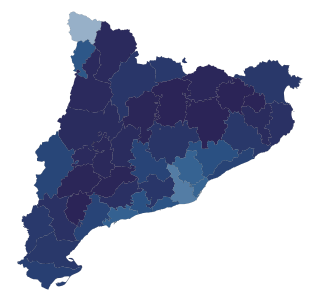Related Research Articles

Catalan, known in the Valencian Community and Carche as Valencian, is a Western Romance language. It is the official language of Andorra, and an official language of three autonomous communities in eastern Spain: Catalonia, the Balearic Islands and the Valencian Community, where it is called Valencian. It has semi-official status in the Italian comune of Alghero, and it is spoken in the Pyrénées-Orientales department of France and in two further areas in eastern Spain: the eastern strip of Aragon and the Carche area in the Region of Murcia. The Catalan-speaking territories are often called the Països Catalans or "Catalan Countries".

Catalonia is an autonomous community of Spain, designated as a nationality by its Statute of Autonomy. Most of its territory lies on the northeast of the Iberian Peninsula, to the south of the Pyrenees mountain range. Catalonia is administratively divided into four provinces or eight regions, which are in turn divided into 42 comarques. The capital and largest city, Barcelona, is the second-most populated municipality in Spain and the fifth-most populous urban area in the European Union.

The Institute for Catalan Studies, also known by the acronym IEC, is an academic institution which seeks to undertake research and study into "all elements of Catalan culture". It is based in Barcelona, Catalonia, Spain.

Aran is an autonomous administrative entity in northwest Catalonia, Spain, consisting of 620.47 square kilometres (239.56 sq mi) in area, located in the Pyrenees mountains, in the Alt Pirineu i Aran region and in the province of Lleida. The capital is Vielha e Mijaran.
The Generalitat de Catalunya, or the Government of Catalonia, is the institutional system by which Catalonia politically organizes its self-government as an autonomous community of Spain. It is formed by the Parliament of Catalonia, the Presidency of the Generalitat de Catalunya, and the Executive Council of Catalonia. It is ruled according to the Statute of Autonomy of Catalonia.

Aranese is a standardized form of the Pyrenean Gascon variety of the Occitan language spoken in the Val d'Aran, in northwestern Catalonia close to the Spanish border with France, where it is one of the three official languages beside Catalan and Spanish. In 2010, it was declared the third official language in Catalonia by the Parliament of Catalonia.
Òmnium Cultural is a Spanish association based in Barcelona, Catalonia. It was originally created in the 1960s to promote the Catalan language and spread Catalan culture.

The Library of Catalonia is the Catalan national library, located in Barcelona, Catalonia, Spain. The primary mission of the Library of Catalonia is to collect, preserve, and spread Catalan bibliographic production and that related to the Catalan linguistic area, to look after its conservation, and to spread its bibliographic heritage while maintaining the status of a center for research and consultation.
The Institut Ramon Llull is a consortium consisting of the Generalitat de Catalunya,, the Govern de les Illes Balears and the Ajuntament de Barcelona. Its purpose is to project and disseminate abroad Catalan language and culture in all of its forms of expression. To do this, the Institut Ramon Llull provides support for external relations in the cultural ambit of its member organisations.

There are four languages with official status in Catalonia : Catalan; Spanish, which is official throughout Spain; Aranese, a dialect of Occitan spoken in the Aran Valley; and Catalan Sign Language. Many other languages are spoken in Catalonia as a result of recent immigration from all over the world.

The R3 is a line of Rodalies de Catalunya's Barcelona commuter rail service, operated by Renfe Operadora. It runs northwards from the Barcelona area to the French border town of Latour-de-Carol, passing through the Vallès Oriental, Osona and Ripollès regions. With a total line length of 165.9 kilometres (103.1 mi), it extends notably beyond the limits of the Barcelona metropolitan area, reaching the Pyrenees mountains. According to 2008 data, the line's average weekday ridership is 22,841.

Rodalies de Catalunya is the main commuter and regional rail system in the Spanish autonomous community of Catalonia. It is administered by the Government of Catalonia and operated by the national rail operator Renfe Operadora. The system consists of 17 service lines chiefly centred in the Barcelona area, serving a total of 203 stations throughout Catalonia, with an average number of 1,000 trains running on it every day. In 2016, it had an annual ridership of 117 million.
The Statute of Autonomy of Catalonia of 2006 provides Catalonia's basic institutional regulations under the Spanish Constitution of 1978. It defines the rights and obligations of the citizens of Catalonia, the political institutions of the Catalan community, their competences and relations with the rest of Spain, and the financing of the Government of Catalonia.

The Diccionari General de la Llengua Catalana by Pompeu Fabra is a Catalan dictionary, first published in fascicles in 1931. It was the Standard Catalan dictionary until 1995, when the Institut d'Estudis Catalans published its Diccionari de la llengua catalana.

A non-binding Catalan self-determination referendum, also known as the Citizen Participation Process on the Political Future of Catalonia, was held on Sunday, 9 November 2014, to gauge support on the political future of Catalonia. While also referred to as "Catalan independence referendum", the vote was rebranded as a "participation process" by the Government of Catalonia, after a "non-referendum popular consultation" on the same topic and for the same date had been suspended by the Constitutional Court of Spain.
The Name and Title Authority File of Catalonia (CANTIC) is an authority union catalogue within the Union Catalogue of Universities of Catalonia (CCUC), that it is led by the Biblioteca de Catalunya. Its goals are to standardize the access points in bibliographic catalogues, to improve communication among catalogues and mainly, to make easier the information research and retrieval. CANTIC gives a special treatment to name and title authorities related with Catalan culture. These authorities receive a complete authority work and provide, eventually, access to the Enciclopèdia Catalana.

Maria Carme Forcadell i Lluís is a Spanish politician from Catalonia. She is the former President of the Parliament of Catalonia, as well as a Catalan high school teacher, known for her Catalan independence activism.
The Dictionary of the Catalan language of the Institute of Catalan Studies (DIEC) is the dictionary of Catalan of the Institute of Catalan Studies (IEC) and, therefore, the standard dictionary of and reference for the Catalan language, together with the dictionary of standard Valencian produced by the AVL.
Optimot, linguistic inquiries, is a service provided by the Directorate - General of Linguistic Policy of the Catalan Government in collaboration with the Institute for Catalan Studies and the Terminology Center TERMCAT. It consists of a search engine for linguistic information that helps to clarify doubts about the Catalan language. With Optimot different sources can be checked at the same time in an integrated way. When the search options provided by Optimot do not manage to answer the linguistic question, a personalized inquiry service can be accessed.
Joan Maria Pujals i Vallvé is a Catalan politician, counselor of the Generalitat of Catalonia and a Member of the Parliament of Catalonia in the fourth, fifth and sixth legislatures.
References
- ↑ "termcat". Termcat. Government of Catalonia. Retrieved 3 February 2015.
- ↑ TERMCAT (ed.). "How to use Cercaterm?". Archived from the original on 14 April 2017. Retrieved 30 March 2017.
- ↑ FRANQUESA, Ester.
- ↑ "2013 Cercaterm update".
- ↑ Franquesa i Bonet, Ester.
- ↑ RUIZ TARRAGÓ, Ferran.
- ↑ FARGAS VALERO, F. Xavier; MONTES PÉREZ, Dolors.
- ↑ «Ja pot haver-hi ‘seqüeles' en català», El Punt Avui,7 October 2010 (2010-10-07)
- ↑ « Actualització de la Neoloteca (gener de 2014)» Archived 8 May 2014 at the Wayback Machine , Consorci per a la normalització lingüística, 2014
- ↑ See for example 17 February 2014 update: RESOLUCIÓ CLT/489/2014, de 17 de febrer, per la qual es publiquen termes normalitzats pel Consell Supervisor del TERMCAT